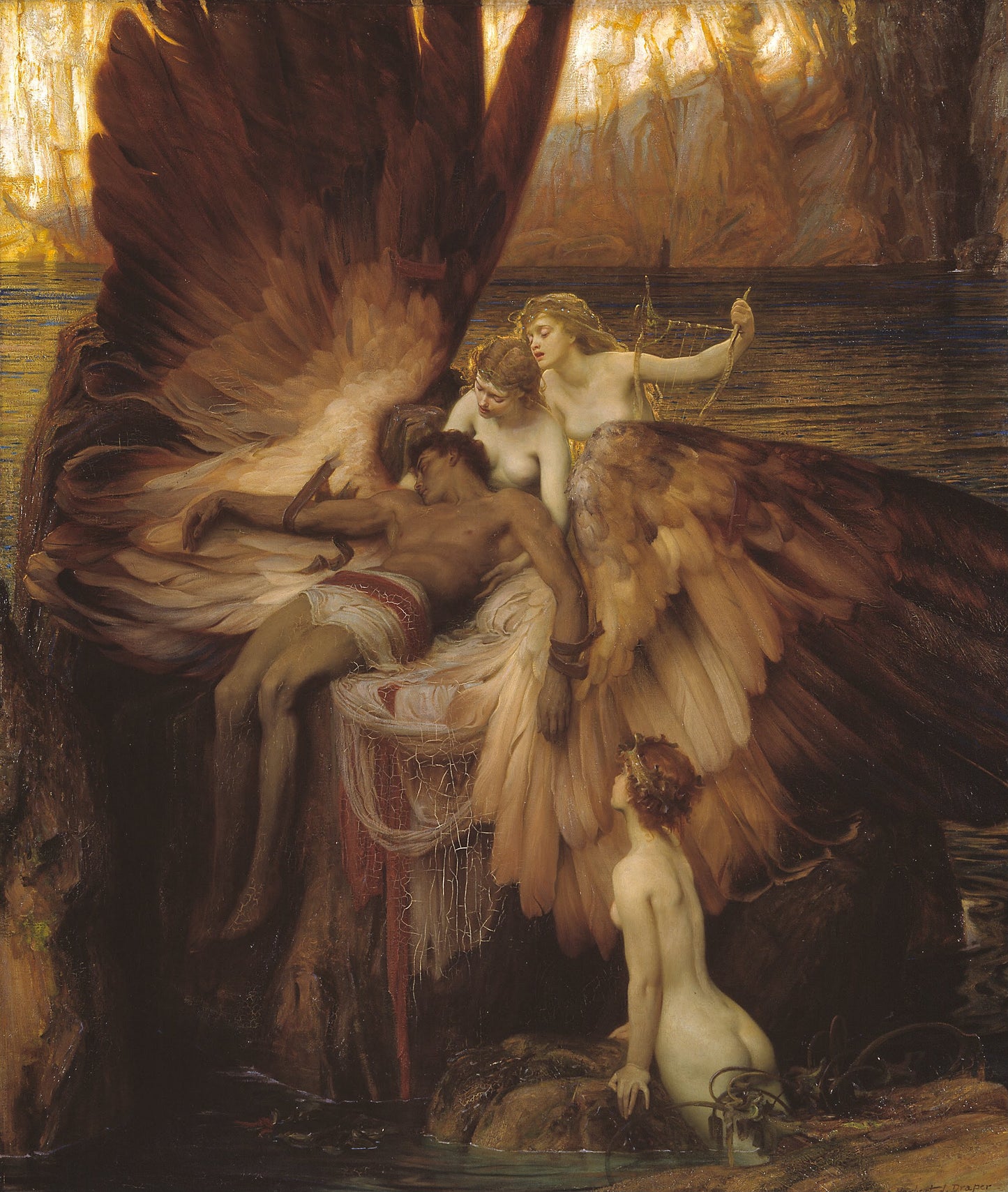Romantic English
The Lament for Icarus Herbert Draper 1898
The Lament for Icarus Herbert Draper 1898
Couldn't load pickup availability
This captivating painting, likely depicting the myth of Icarus, is a stunning example of mythological tragedy rendered in all its glorious pathos. It speaks of the moment after the great fall, where the triumph of flight has given way to the bitter consequence of hubris.
At the center of this emotional and dramatic composition lies the figure of Icarus, his body lifeless, cradled in the warm embrace of the very wings that led him to his demise. The wings themselves, rendered with masterful precision, are rich and feathered, sweeping around Icarus in a soft arc, as though to shield him from the harshness of his fate. The wings' rich golden-brown hues catch the light, creating a striking contrast to Icarus’s sun-kissed skin. There is a sense of tenderness in the way the wings envelop him, as if they too lament the tragedy they have played a role in.
Icarus’s body, sprawled and limp, is marked by classical perfection—his musculature beautifully defined, his pose almost languid, despite the mortal gravity of the scene. His head leans back, his eyes closed, lips slightly parted, as though sleep has claimed him rather than death. His right arm dangles loosely, while his left rests upon his chest, where the sun's golden rays seem to bathe his skin in an otherworldly glow. His cloth loin is draped loosely around his waist, the white fabric fluttering, adding a sense of lightness in contrast to the weight of the moment.
Surrounding him are three ethereal figures—mythical nymphs, no doubt—who have come to mourn his fall. Their alabaster skin glows softly in the golden light, their expressions tender and sorrowful. One of them holds Icarus gently, her face turned towards him in a quiet gesture of grief. Her hands rest delicately upon his shoulders, and her golden hair cascades down her back, merging with the warmth of the light that fills the scene.
Behind her, another nymph leans forward, her expression filled with empathy and sadness, as if silently lamenting the consequence of his youthful folly. She seems to offer no solace but only quiet understanding, an acknowledgment of his fate. The third nymph, positioned lower in the composition, gazes upward, her eyes locked on the fallen figure. Her pose—kneeling in the water, her hair crowned with a simple wreath—adds to the painting’s allegory of loss and the pull between life and death.
The setting itself is resplendent with dramatic lighting, where golden rays pour down from above, illuminating the scene in a celestial glow. The light bounces off the reflective surface of the water, creating a shimmering effect that brings a sense of magic and timelessness to the painting. In the distance, rocky cliffs rise steeply from the water’s edge, their jagged, shadowed forms contrasting with the warm light that bathes the figures.
The composition is balanced beautifully between shadow and light, grief and grace. The colors are rich, with the brown and gold tones of the wings melding seamlessly into the nymphs’ pale skin and the water’s reflective surface. The setting sun’s warm glow heightens the emotional intensity of the moment, casting long shadows and highlighting the contours of the figures.
The narrative here is clear: Icarus has fallen. His wings—those symbols of ambition and youthful defiance—lie broken around him, yet they still retain their beauty. The nymphs, gentle guardians of the sea, come not to rescue but to mourn. The viewer is left with a bittersweet feeling, one of awe at the beauty of the composition, but also of profound sadness at the fragility of human ambition.
The artist has captured the essence of the Icarus myth with a sensitivity that both celebrates the glory of flight and laments the tragedy of its loss. In every brushstroke, there is reverence for the myth, for the hero who dared to defy the gods, and for the eternal consequences of reaching too high. The painting is a haunting and beautiful reminder of the delicate balance between aspiration and downfall, where the beauty of flight is forever married to the inevitability of the fall.
Share


